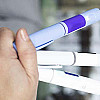Signaling the brain to lower blood pressure
For some people, controlling blood pressure is a matter of eating a healthier diet, exercising more, and reducing stress. Others must add one or more medications. When these standard approaches don't do the trick, a novel technique that uses a pacemaker-like device may someday help.
The Rheos system (see illustration) works on baroreceptors (patches of nerve endings that are sensitive to changes in blood pressure) located inside the carotid arteries that run up either side of the neck. The device stimulates these baroreceptors using a pacemaker-like pulse generator connected to wire leads that run to each baroreceptor.
To continue reading this article, you must log in.
Subscribe to Harvard Health Online for immediate access to health news and information from Harvard Medical School.
- Research health conditions
- Check your symptoms
- Prepare for a doctor's visit or test
- Find the best treatments and procedures for you
- Explore options for better nutrition and exercise
I'd like to receive access to Harvard Health Online for only $4.99 a month.
Sign Me UpAlready a member? Login ».
Disclaimer:
As a service to our readers, Harvard Health Publishing provides access to our library of archived content. Please note the date of last review or update on all articles.
No content on this site, regardless of date, should ever be used as a substitute for direct medical advice from your doctor or other qualified clinician.















